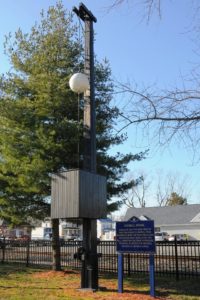RARE ITEM
The rare item pictured has been awarded a National Register of Historic Places listing. It is located on the border between Delaware and Maryland in Delmar but originally found use in northern Delaware as well as 25 miles away in Hurlock, Maryland. After serving some of its life in Cape Charles, Virginia, it has been returned to Delaware. What is the pictured item called, and how was it used?

Answer
The item pictured is a railroad Highball Signal dating from the earliest railroads that operated on the DelMarVa Peninsula. From the Delmar Highball Signal’s National Register Listing;
The term highball, meaning a fast train, or permission for a train to proceed at full speed, derives from this type of signal. A highball signal was a white sphere mounted on a pole next to the railroad tracks. If the track was clear ahead, the signal attendant would raise the ball to the top of the pole by means of a pulley. If the track was not clear, he would lower the ball so that it would not be visible to the engineer of an oncoming train; hence, the term highball came to be synonymous with a clear right-of-way. Positioned as shown in the image, at the midpoint of the pole, the signal indicated the engineer was to proceed ahead slowly with caution.

Highball signals were frequently mounted near stations or at section boundaries. The design of highball signals varied among the railroads; some were equipped with a black ball that would replace the white one when the track was not clear. Some signals, like the one at Delmar, were provided with a box into which the ball was lowered when the track was not clear. Some railroads constructed the ball with glass windows such that it included a kerosene font and burner and could be lit at night for better visibility. Other types of signal, notably the semaphore and the three-light electrical signal, eventually replaced the highball. The highball at Delmar is a steel sphere mounted on a wooden post, which is raised and lowered by of a chain hoist. It is no longer used to direct railroad traffic, but is maintained as a public exhibition in a park near the railroad.
The highball signal at Delmar is one of the last survivors of a type of traffic control that was in use before the advent of modern semaphore signals. The origin of the highball is unknown, but it probably was invented during the railroad expansion period of the 1840’s. As a signal, it is quite primitive, since it can convey only one piece of information: whether the track is clear or not. Modern signaling devices can transmit a variety of data to the engineer of an oncoming train. The last highball signal on a class 1 railroad in America was in operation at the interchange point between the Pennsylvania and Reading railroads near Wilmington Delaware, a few years ago; the highball was used at that point because the electronic control systems of the two railroads ended short of the interchange track and manual signaling was necessary.
The Delmar highball signal was originally in service at New Castle, Delaware, and then at Hurlock, Maryland. It was displayed for a time at Cape Charles, Virginia, and then was moved to Delmar, Delaware for display during the town’s centennial in 1959. It is maintained as a permanent exhibit by the town of Delmar, Delaware.
